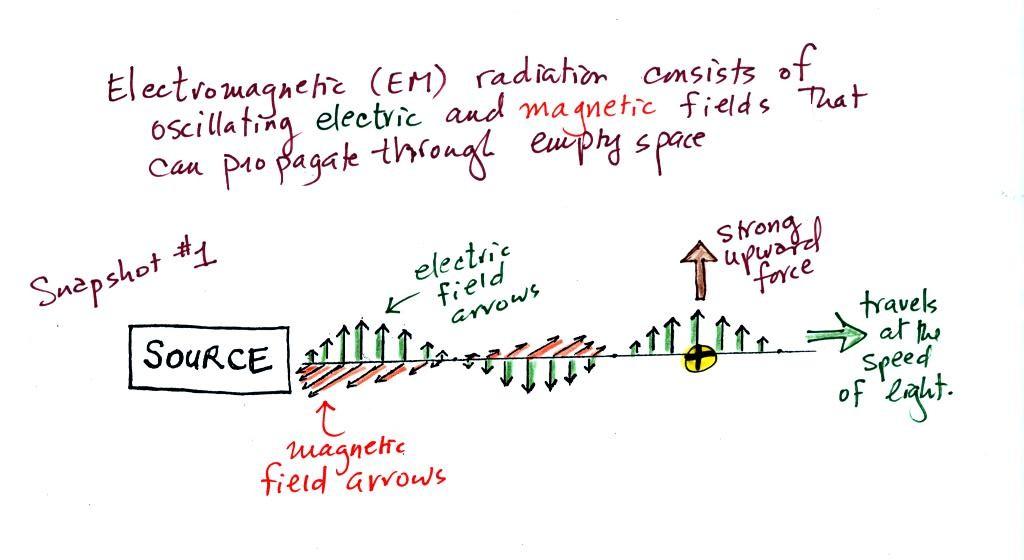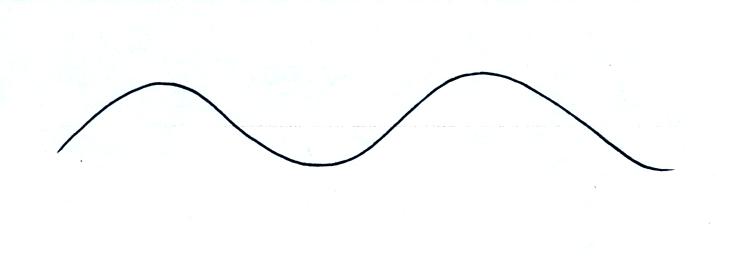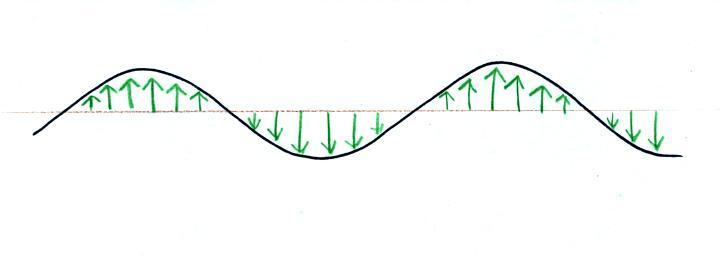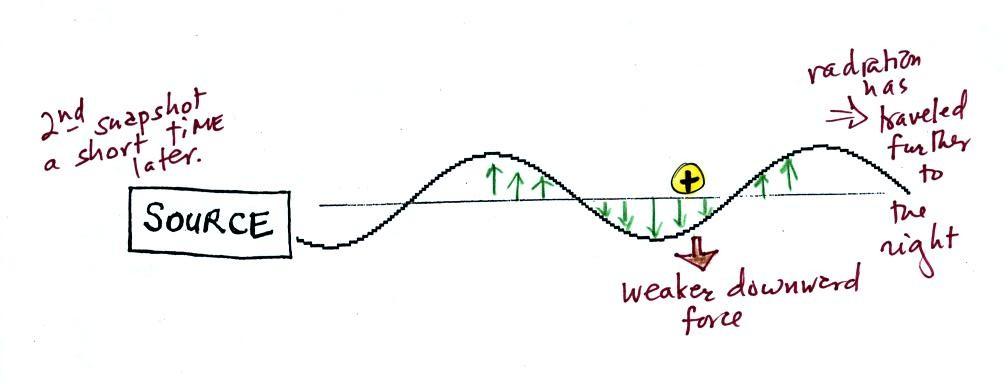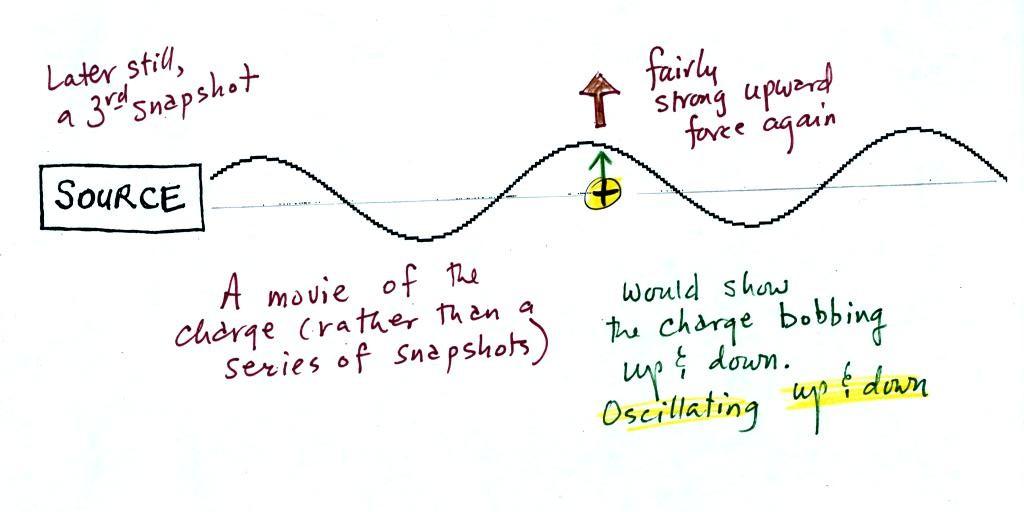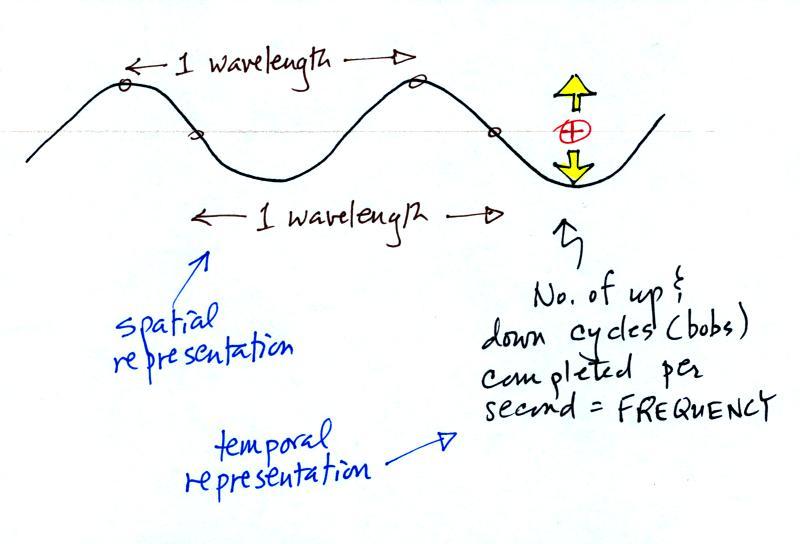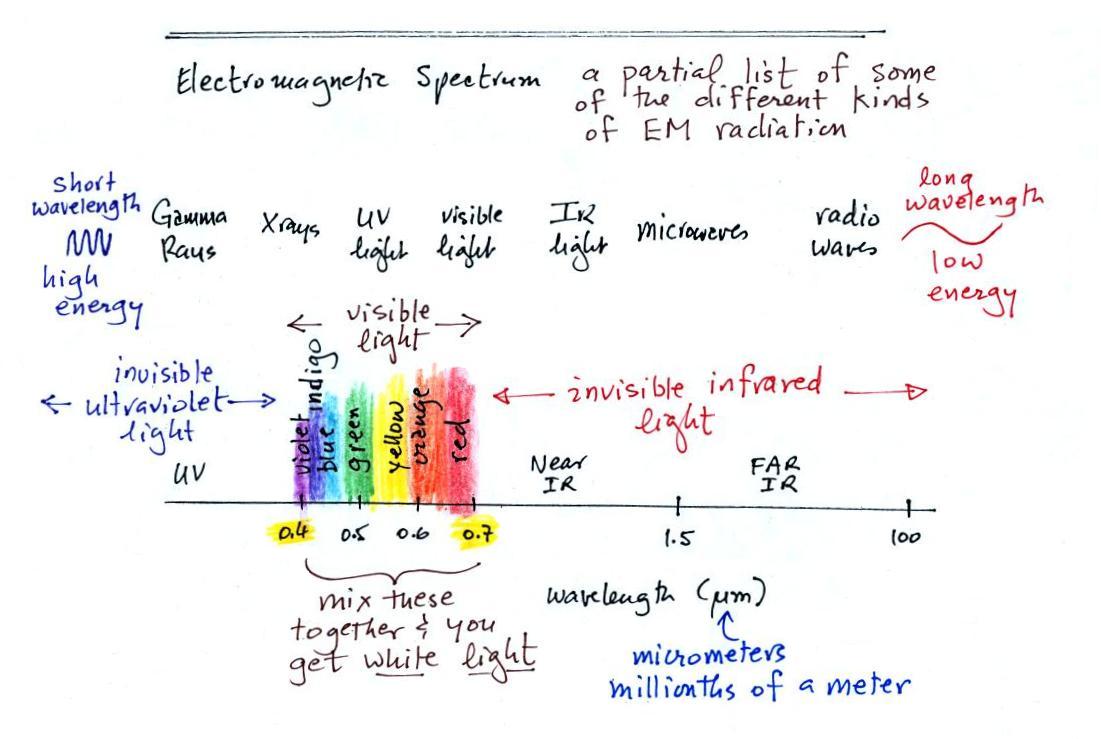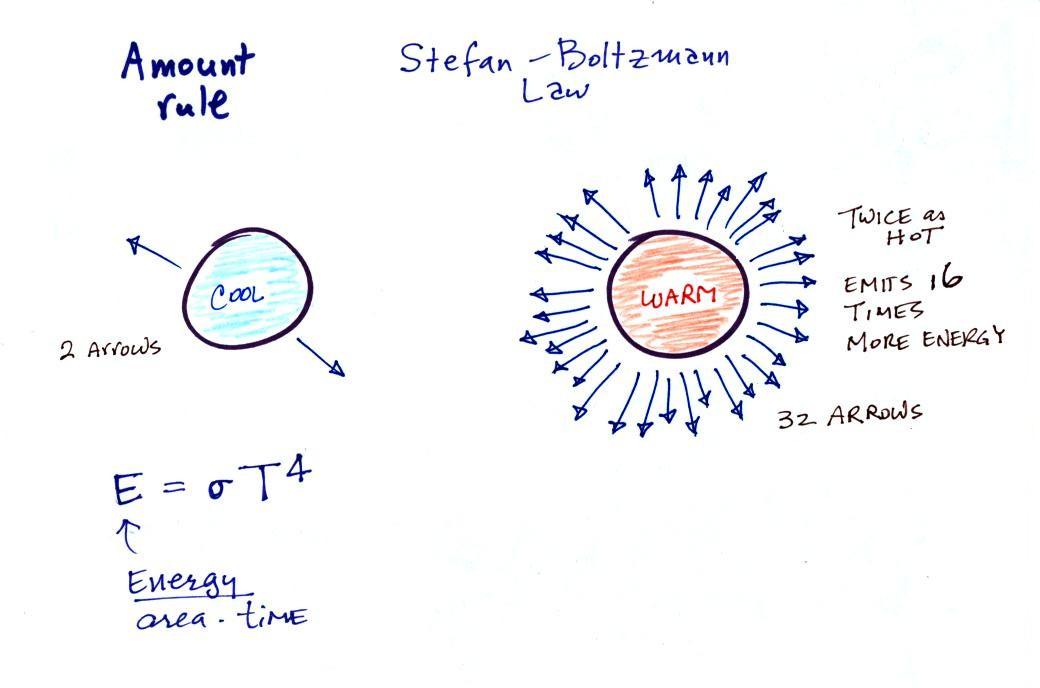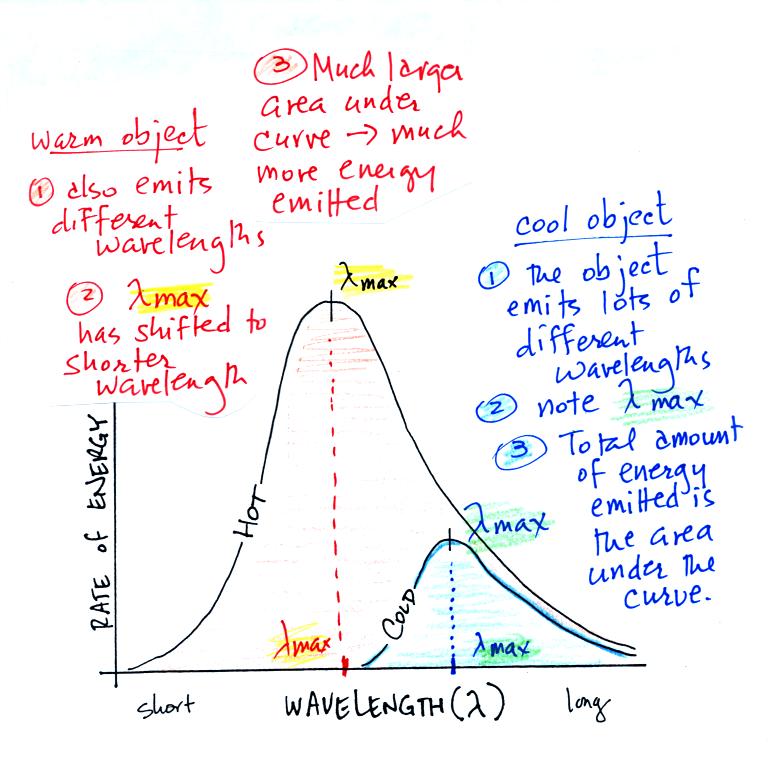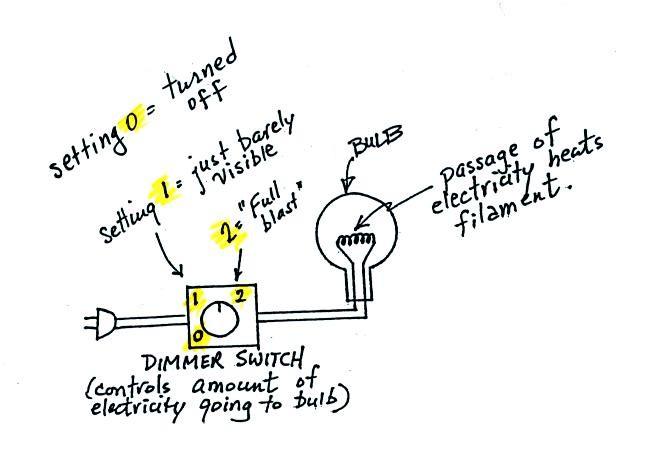Friday Oct. 5, 2012
click here to
download today's notes in a more printer friendly format
I try to save the unusual music for Friday afternoon. The
first song was "Hold
On", the second "Baka" from a
group named Outback.
Now we'll use what we know about electric fields to start to
understand electromagnetic radiation.
An electric field
arrow
shows the
direction and
gives an idea
of the strength
of the
electrical force
that would be
exerted on a positive charge
You'll find most of the following on p. 60
in the photocopied ClassNotes.
We imagine turning on a source of
EM radiation and then
a
very short time
later we take a snapshot. In that time the EM radiation has
traveled to the right (at the speed of light). The EM radiation
is a wavy pattern of
electric and magnetic field arrows. We'll ignore the
magnetic
field lines. The E field lines sometimes point up, sometimes
down. The pattern of electric field arrows repeats itself.
Textbooks often represent EM
radiation with a wavy line like shown
above. They don't usually explain what the wavy line represents.
The wavy line just connects the
tips of a bunch of electric
field
arrows.
Th picture above was taken a short
time
after the first snapshot aftere the radiation
had
traveled a little further to the right. The EM radiation now
exerts a somewhat weaker downward force on the + charge.
A 3rd snapshot taken a short time
later. The +
charge is now being
pushed upward again.
A
movie
of
the +
charge, rather than just a series of snapshots, would show the
charge
bobbing up and down much like a swimmer in the
ocean would do as waves passed by.
The wavy pattern used to
depict EM radiation can be described spatially (what you would
see in a snapshot) in terms of its
wavelength,
the distance between identical points on the pattern.
Or you can
describe the radiation temporally
using the frequency of oscillation
(number of up and down cycles completed by an oscillating charge per
second). By temporally we mean you look at one particular fixed
point and look at how things change with time.
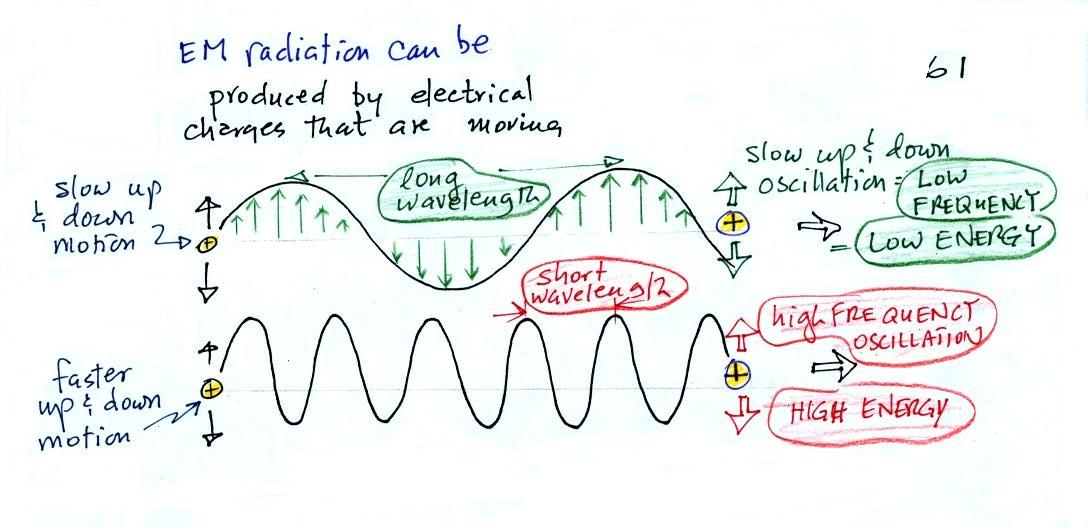
EM radiation can be created when
you cause a charge to move up and
down.
If you move a charge up and down slowly (upper left in the
figure above) you would produce long wavelength radiation that would
propagate out to the right at the speed of light. If you move the
charge up and down more rapidly you produce short wavelength radiation
that propagates at the same speed.
Once the EM radiation encounters the charges at the right side of
the
figure above the EM radiation causes those charges to oscillate up and
down. In the case of the long wavelength radiation the charge at
right oscillates slowly. This is low frequency and low energy
motion. The short wavelength causes the charge at right to
oscillate more rapidly - high frequency and high energy.
These three characteristics: long wavelength / low frequency / low
energy go
together. So do short wavelength / high frequency / high energy.
Note that the two different types of radiation both propagate at the
same speed.
The
following
figure, not
shown in class,
illustrates how energy can be
transported from one
place to another (even through empty space) in the form of
electromagnetic (EM) radiation.
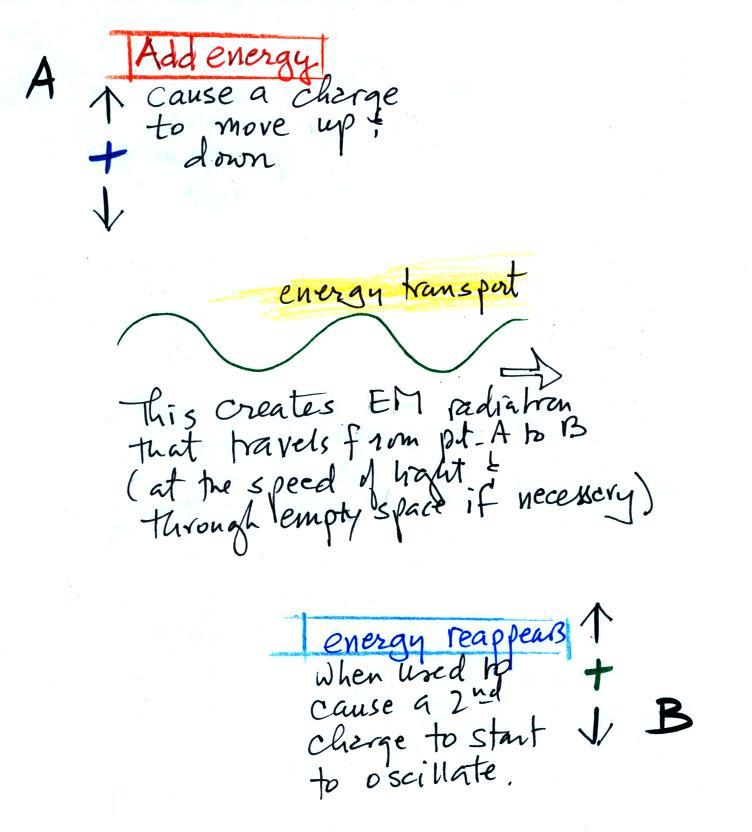
You add energy when you cause an
electrical charge to move up and down
and create the EM radiation (top left).
In the middle
figure, the EM
radiation that is produced then travels out
to the
right (it could be through empty space or through something like the
atmosphere).
Once
the EM radiation encounters an electrical charge at another location
(bottom right),
the energy reappears as the radiation causes the charge to move.
Energy
has been transported from left to right.
This is really just a partial list
of some of the different
types of EM
radiation. In the top list, shortwave length and high energy
forms of EM radiation are on the left (gamma rays and X-rays for
example). Microwaves and radiowaves are longer wavelength, lower
energy forms of EM radiation.
We will mostly be concerned with just ultraviolet light (UV),
visible
light (VIS), and infrared light (IR). Note the micrometer
(millionths of a meter) units used for wavelength for these kinds of
light. The visible
portion of the spectrum falls between 0.4 and 0.7 micrometers.
UV and
IR light are both invisible. All of the vivid colors
shown above
are just EM radiation with slightly different wavelengths. When
you see all of these colors mixed together, you see white light.
Here are some rules governing the
emission of electromagnetic
radiation:
1.
Unless an object
is very cold (0
K) it will emit EM
radiation. Everything in the classroom: the people, the
furniture, the walls and the floor, even the air, are emitting EM
radiation. Often
this radiation
will be invisible so that we can't see it and weak enough that we can't
feel it (or perhaps because it is always there we've grown accustomed
to it and ignore it). Both the amount and kind (wavelength) of
the emitted
radiation depend on the object's temperature.
2.
The second rule
allows you to
determine the amount of EM radiation (radiant energy) an object will
emit. Don't worry about the units,
you can think of this as amount, or rate, or intensity.
Don't worry about σ (the Greek character
rho) either, it is just a
constant. The amount depends on temperature to
the fourth
power. If the temperature of an object doubles the amount of
energy emitted will increase by a factor of 2 to the 4th power
(that's 2 x 2 x 2 x 2 = 16). A hot object just doesn't emit a
little more energy than a
cold object it emits a lot more energy than a cold object. This
is illustrated in the following figure:
The cool object is emitting 2
arrows worth of energy. The
warmer object is 2 times warmer and is emitting 32 arrows (16 times
more energy).
3.
The third rule
tells you something
about the kind of radiation emitted
by an object. We will see that objects usually emit radiation at
many different wavelengths but not in equal amounts. But, objects
emit
more of one particular wavelength than any of the others. This is
called λmax ("lambda max", lambda is the
greek character used to
represent wavelength) and is the wavelength of maximum
emission. The third rule allows
you to calculate λmax.
The
tendency
for
warm
objects
to
emit radiation at shorter wavelengths is shown below.
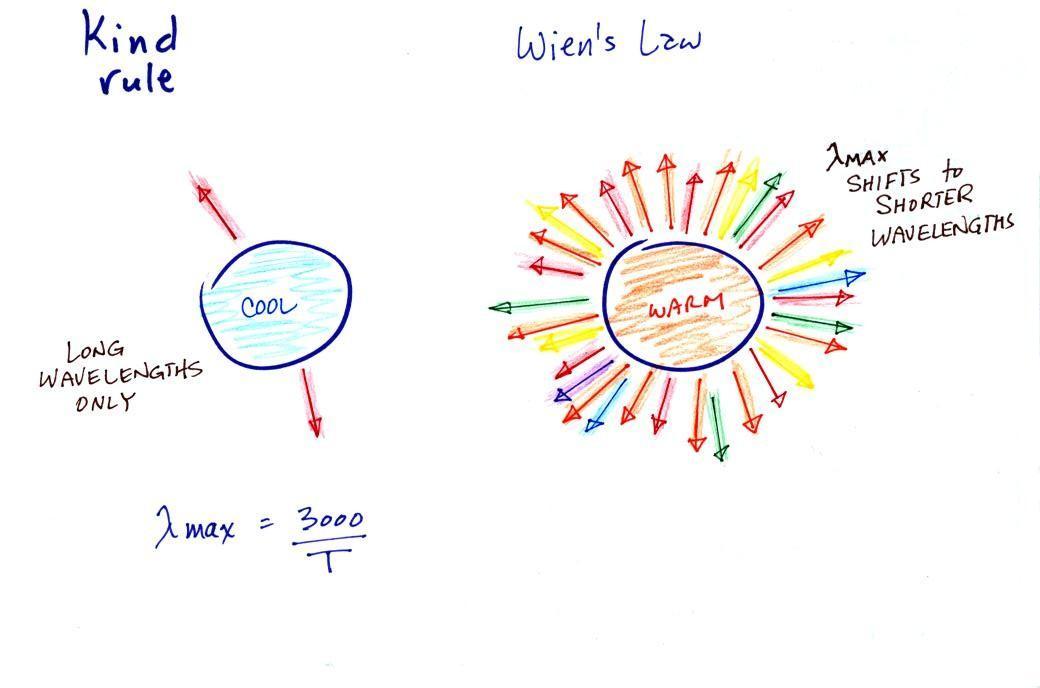
I think I may have
forgot to mention in class that this is called "Wien's Law."
The cool object is probably
emitting
infrared light so the 2 arrows of energy are colored red. The
warmer object will also emit IR light but also shorter
wavelengths such as yellow, green, blue, and violet (maybe even some UV
if it's warm enough).
If the cool object were warm enough to be emitting a
little visible light it would
probably appear red or orange. In that case the warmer object
would emit some of the shorter wavelengths of visible light and would
probably appear white.
The graphs at the bottom of p. 65 in the photocopied
ClassNotes also help to
illustrate the Stefan-Boltzmann law
and Wien's laws. We're really beating this topic to death.
1.
Notice first
that both and warm
and
the cold objects emit radiation
over a range of wavelengths (the curves above are like quiz scores, not
everyone gets the same score, there is a distribution of grades).
The warm object emits all the wavelengths the cooler object does plus
lots of additional shorter wavelengths.
2.
The peak of each
curve is λmax. Note
that λmax has
shifted toward
shorter wavelengths for the warmer
object. This is Wien's law in action. The warmer object is
emitting lots of types of short wavelength radiation that the colder
object
doesn't emit.
3.
The area under
the warm object
curve is much bigger than the area under
the cold object curve. The area under the curve is a measure of
the total radiant energy emitted by the object. This illustrates
the fact that the warmer object emits a lot more radiant energy than
the colder object.
And finally a demonstration.
It consisted of an
ordinary 200 W tungsten bulb is connected to a dimmer switch (see p. 66
in the photocopied
ClassNotes). We'll be looking at the EM radiation emitted by the
bulb
filament.
The graph at the bottom of p. 66 has been split up into 3 parts
and
redrawn for improved clarity.
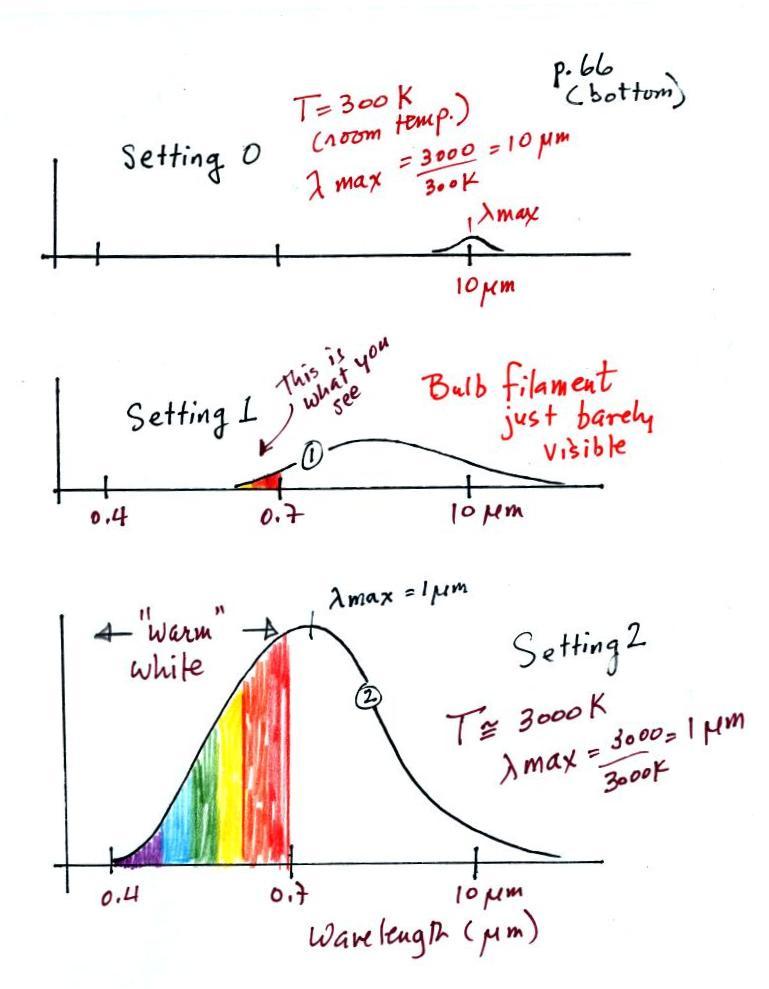
We start with the bulb turned off (Setting 0).
The
filament will be at room temperature which we will assume is around 300
K (remember that is a reasonable and easy to remember value for the
average temperature of the earth's surface). The bulb will be
emitting radiation, it's shown on the top graph above. The
radiation is very weak so we
can't
feel it. The wavelength of peak emission is 10
micrometers which is long wavelength, far IR radiation so
we
can't see it.
Next we use the dimmer switch to just barely turn the bulb on (the
temperature of the filament is now about 900 K).
The bulb wasn't very bright at all and had an orange color. This
is curve 1, the middle figure. Note the far left end of the
emission curve has
moved left of the 0.7 micrometer mark - into the visible portion of the
spectrum. That is what you were able to see, just the small
fraction of
the radiation emitted by the bulb that is visible light (but just
long wavelength red and orange light). Most of the radiation
emitted by the bulb is to the right of the 0.7 micrometer mark and is
invisible IR radiation (it is strong enough now that you could feel it
if you put your hand next to the bulb).
Finally we turn on the bulb completely (it was a 200 Watt bulb so
it
got
pretty bright). The filament temperature
is now about 3000K. The bulb is emitting a lot more visible
light, all the colors, though not all in equal amounts. The
mixture of the colors produces a "warm
white" light. It is warm because it is a mixture that contains a
lot more red, orange, and yellow than blue, green, and violet
light. It is interesting that most of the radiation emitted by
the bulb is still in the IR portion of the spectrum (lambda max is 1
micrometer). This is
invisible light. A tungsten bulb like this is not especially
efficient, at least not as a source of visible light.
You were able to use one of the diffraction gratings
handed out in class to
separate the
white light produced by the bulb into its separate colors.
When you looked at the bright white bulb filament through one of
the
diffraction gratings the colors were smeared out to the right and left
as shown below.
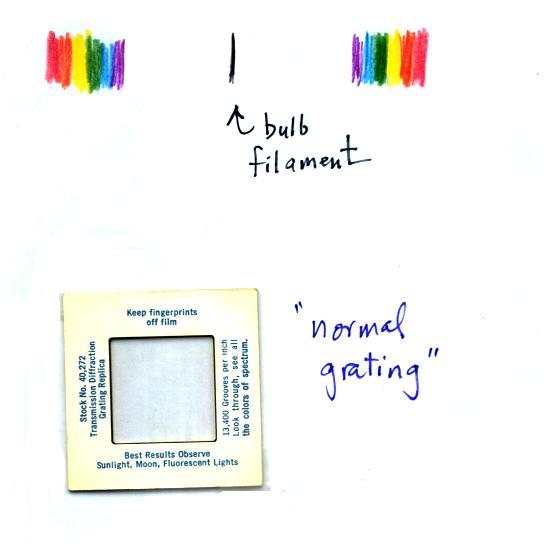
Some of the gratings handed out in
class behaved a little
differently
and spread out the colors horizontally, vertically, and diagonally.
